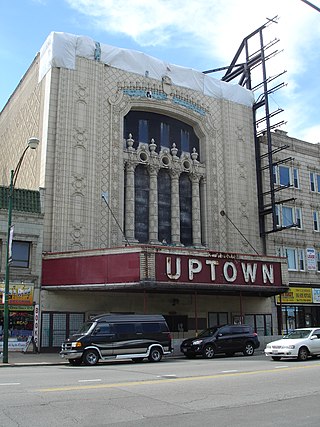
A movie palace is a large, elaborately decorated movie theater built from the 1910s to the 1940s. The late 1920s saw the peak of the movie palace, with hundreds opening every year between 1925 and 1930. With the advent of television, movie attendance dropped, while the rising popularity of large multiplex chains in the 1980s and 1990s signaled the obsolescence of single-screen theaters. Many movie palaces were razed or converted into multiple-screen venues or performing arts centers, though some have undergone restoration and reopened to the public as historic buildings.

Municipal Auditorium is a multi-purpose facility located in Kansas City, Missouri. It opened in 1935 and features Streamline Moderne and Art Deco architecture and architectural details.
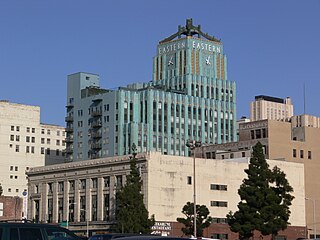
The Historic Core is a district within Downtown Los Angeles that includes the world's largest concentration of movie palaces, former large department stores, and office towers, all built chiefly between 1907 and 1931. Within it lie the Broadway Theater District and the Spring Street historic financial district, and in its west it overlaps with the Jewelry District and in its east with Skid Row.

The Pellissier Building and adjoining Wiltern Theatre is a 12-story, 155-foot (47 m) Art Deco landmark at the corner of Wilshire Boulevard and Western Avenue in Los Angeles, California. The entire complex is commonly referred to as the Wiltern Center. Clad in a blue-green glazed architectural terra-cotta tile and situated diagonal to the street corner, the complex is considered one of the finest examples of Art Deco architecture in the United States. The Wiltern building is owned privately, and the Wiltern Theatre is operated by Live Nation's Los Angeles division.

Broadway, until 1890 Fort Street, is a thoroughfare in Los Angeles County, California, United States. The portion of Broadway from 3rd to 9th streets, in the Historic Core of Downtown Los Angeles, was the city's main commercial street from the 1910s until World War II, and is the location of the Broadway Theater and Commercial District, the first and largest historic theater district listed on the National Register of Historic Places (NRHP). With twelve movie palaces located along a six-block stretch of Broadway, it is the only large concentration of movie palaces left in the United States.

The Homer Laughlin Building, at 317 South Broadway in Downtown Los Angeles, is a landmark building best known for its ground floor tenant the Grand Central Market, the city's largest and oldest public market that sees 2 million visitors a year.

Stiles Oliver Clements was an architect practicing in Los Angeles and Southern California.

The Million Dollar Theatre at 307 S. Broadway in Downtown Los Angeles is one of the first movie palaces built in the United States. It opened in 1917 with the premiere of William S. Hart's The Silent Man. It's the northernmost of the collection of historical movie palaces in the Broadway Theater District and stands directly across from the landmark Bradbury Building. The theater is listed in the National Register of Historic Places.

The Eastern Columbia Building, also known as the Eastern Columbia Lofts, is a thirteen-story Art Deco building designed by Claud Beelman located at 849 S. Broadway in the Broadway Theater District of Downtown Los Angeles. It opened on September 12, 1930, after just nine months of construction. It was built at a cost of $1.25 million as the new headquarters and 39th store for the Eastern-Columbia Department Store, whose component Eastern and Columbia stores were founded by Adolph Sieroty and family. At the time of construction, the City of Los Angeles enforced a height limit of 150 feet (46 m), however the decorative clock tower was granted an exemption, allowing the clock a total height of 264 feet (80 m). J. V. McNeil Company was the general contractor.
Claud W. Beelman, sometimes known as Claude Beelman, was an American architect who designed many examples of Beaux-Arts, Art Deco, and Streamline Moderne style buildings. Many of his buildings are listed on the National Register of Historic Places.
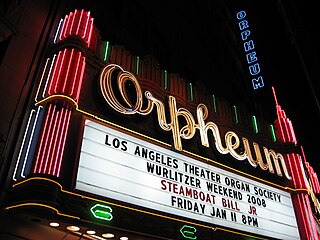
The Orpheum Theatre at 842 S. Broadway in Downtown Los Angeles opened on February 15, 1926, as the fourth and final Los Angeles venue for the Orpheum vaudeville circuit. After a $3 million renovation, started in 1989, it is the most restored of the historical movie palaces in the city. Three previous theatres also bore the name Orpheum before the one at 842 Broadway was the final one with that moniker.

The Ace Hotel Downtown Los Angeles, originally built as the California Petroleum Corporation Building and later known as the Texaco Building, is a 243 ft (74 m), 13-story highrise hotel and theater building located at 937 South Broadway in downtown Los Angeles, California. It was the tallest building in the city for one year after its completion in 1927, and was the tallest privately owned structure in Los Angeles until 1956. Its style is Spanish Gothic, patterned after Segovia Cathedral in Segovia, Spain.

The Broadway Theater District in the Historic Core of Downtown Los Angeles is the first and largest historic theater district listed on the National Register of Historic Places (NRHP). With twelve movie palaces located along a six-block stretch of Broadway, it is the only large concentration of movie palaces left in the United States. The same six-block stretch of Broadway, and an adjacent section of Seventh Street, was also the city's retail hub for the first half of the twentieth century, lined with large and small department stores and specialty stores.
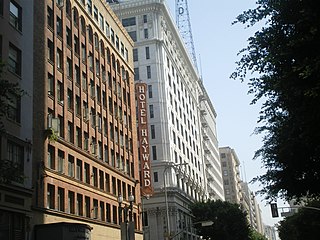
Spring Street in Los Angeles is one of the oldest streets in the city. Along Spring Street in Downtown Los Angeles, from just north of Fourth Street to just south of Seventh Street is the NRHP-listed Spring Street Financial District, nicknamed Wall Street of the West, lined with Beaux Arts buildings and currently experiencing gentrification. This section forms part of the Historic Core district of Downtown, together with portions of Hill, Broadway, Main and Los Angeles streets.

Samuel Tilden Norton, or S. Tilden Norton as he was known professionally, was a Los Angeles–based architect active in the first decades of the 20th century. During his professional career he was associated with the firm of Norton & Wallis, responsible for the design of many Los Angeles landmarks.
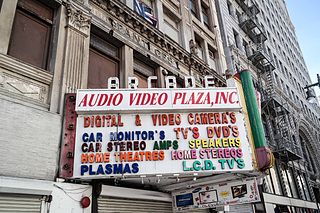
The Arcade Theatre is a historic former vaudeville and movie theater in the Broadway district of Los Angeles, California. Commissioned by real estate developer William May Garland in 1910, it originally operated under the direction of Alexander Pantages. In 1920, the Pantages operation moved to a new auditorium on 7th Street; thereafter, the theater became known as Dalton's Broadway for two years before ultimately taking the Arcade name in 1924 in association with the adjacent Spring Arcade building. Metropolitan Theatres later operated the facility as a grindhouse until its closure in 1992.

Walker & Eisen (1919−1941) was an architectural partnership of architects Albert R. Walker and Percy A. Eisen in Los Angeles, California.

The Bumiller Building is a residential building in the Los Angeles Historic Broadway Theater District. Built in 1906 and designed by the architects Morgan & Walls, the Bumiller Building was constructed of reinforced concrete in Renaissance Revival style. Historically the building has been a department store and a theater.

The Ricardo Montalbán Theatre is a theater in the Hollywood section of Los Angeles.

The Cameo Theatre is a historic former movie theater on Broadway in Los Angeles, California. Opened by film mogul W. H. Clune as Clune's Broadway Theatre in 1910, it was one of the first purpose-built movie theaters in the United States. It remained the oldest continually operating movie theater in Los Angeles until its closure in 1991. Alfred Rosenheim designed the building in the Neoclassical style.




















